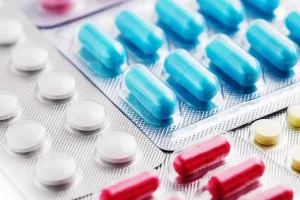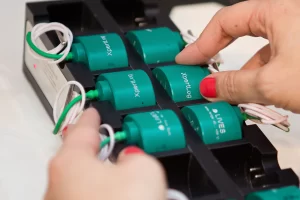Temperature under control – ambient unit temperature mapping
The pharmaceutical and biopharmaceutical industry are one of the most regulated environments on the market. Medicinal product to be released on the market needs to meet very strict quality requirements which are not only limited to the production and hygienic regime but also storage and transport conditions.
One of the critical aspects of medicinal product storage and transport is the environmental conditions – including but not limited to temperature. This parameter, can sometimes include humidity, required during ambient unit temperature mapping study.
In this article the ambient temperature mapping study for the transport units will be described and discussed. We will have a close look into requirements, good execution practice and approaches to ambient unit temperature mapping.
Before we dive into details let’s start with some definitions and types of products which require ambient temperature for storage and transport.
Temperature mapping
Temperature mapping is an activity which determines the temperature and humidity (if required) profile of an ambient transport unit using specific tests for defined durations of time. To perform the study calibrated sensors called data loggers, are temporarily installed within different, pre-defined locations of the ambient unit. The main task of the data loggers is to record the ambient unit location’s temperature over a set period.
The main outcome of the study is to determine the differences between measured point locations within the ambient unit or the temperature fluctuation within the unit over a specific time duration. Moreover, temperature mapping also identifies hot and cold spots of the unit, results used to identify location of ongoing monitoring probes, determine if the unit is capable of maintaining the product storage conditions on a consistent basis across seasonal extremes
Ambient unit
The best description of an ambient unit/area could be given as: the unit (e.g.: van, truck)/area (e.g.: warehouse room where room temperature within the unit is maintained and constantly monitored). But what exactly is room temperature and what products are required to be kept in this temperature? The United State Pharmacopeia (USP) chapter 1079 Good Storage and Shipping Practice gives some clarification. According to USP, room temperature is defined as temperatures between +20 0C – +250C with excursions permitted between +150C and +300C. In many cases, for ambient temperature mapping study, the acceptance criteria are set up as +200C with ±50C variation [limit 150C – 250C].
Products
Many pharmaceutical products are required to be stored and transported within ambient temperatures. Many times, when we buy prescribed medicine (tablets, powder, capsules) from the pharmacy, the following descriptions could be seen on the containers: “ambient”, “store below 250C / 300C”, “Do not store above 250C/300C”. If you have ever seen those on the package you can be sure that the product was stored and transport within ambient conditions. You can be also assured that the storage areas and ambient transport units have been temperature mapped and qualified before your tablets reach you in the pharmacy. It is no different for raw materials, excipients, or active pharmaceutical ingredients (API). Many of them require ambient temperature conditions to ensure their stability within the final pharmaceutical product.
Why perform ambient unit temperature mapping?
But why do we really need or want to control temperature within ambient temperature units? The answer could be as quick and simple as: to avoid the risk of losing product property for its intendent use during the transport and storage.
On the other side, the pharmaceutical and biopharmaceutical industry is dealing with patient safety and delivery of a successful therapy, which are directly merged with product quality. Therefore, a distributor and wholesaler are obligated to follow the Good Distribution Practice Guidelines (2013/C 343/01) and more specifically Chapter 9: “It is the responsibility of the supplying wholesale distributor to protect medicinal products against breakage, adulteration and theft, and to ensure that temperature conditions are maintained within acceptable limits during transport. Regardless of the mode of transport, it should be possible to demonstrate that the medicines have not been exposed to conditions that may compromise their quality and integrity. A risk-based approach should be utilised when planning transportation.”
In the pharmaceutical industry, constantly monitoring temperatures for the storage and transport of materials within ambient units is not only the wish of the distributor or wholesaler but a legal obligation to be met.
How to prepare and execute ambient unit temperature mapping?
Now, when we know what ambient temperature mapping is, we are familiarised with examples of product types requiring ambient temperature and why is it so important to maintain the product at ambient storage conditions during storage and transportation, the time has come to talk about how to perform good temperature mapping.
Risk assessment
As with all activities in the pharma world, it begins with good planning. This is no different for an ambient unit temperature mapping study, which should start with a risk assessment.
Follow ICH Q9 risk assessment “consists of the identification of hazards and the analysis and evaluation of risks associated with exposure to those hazards.”, therefore for ambient unit temperature mapping you should consider but not limit to:
- Product properties such as: transport conditions, sensitivity to sunlight or other artificial source of light (e.g.: UV light)
- Purpose of ambient unit: storage, transport, transport pre-conditioning
- Ambient unit layout and configuration: walls and obstructions, fixed racks, temporary racks, pallets on floors, duct supply and return, locations, transport route length.
- Location of ambient unit: geographic with respect to external climate exposures, climate zones changing during the transport, physical location within ambient temperature unit, windows, doors, traffic, and access frequency.
- Operating characteristics of the heating systems within ambient unit: redundant systems, number of units supporting, storage space and how they interact with each other
A major point of consideration prior to performing an ambient temperature are the sensors (data loggers) – their quantity and location within the ambient unit. But first let’s say what the Data loggers are. Data loggers are sensors which record the required data such as: temperature, humidity, CO2 concentration, during an ambient unit mapping study. Their numbers should be established during the risk assessment and consider ambient unit volume, shelf and racks quantity. Moreover, the dataloggers locations used for ambient unit temperature mapping should be defined based on:
- Product location during storage and/or transport
- Sources of potential major influences during study (racks, humidifier, windows)
- Heating/cooling units, their locations and numbers.
Other than internal loggers one of them need to be located outside the ambient unit. The external logger is gathering surrounding environmental temperatures and its data will be used to define if external conditions impact the internal ambient temperatures.
Ambient unit temperature mapping – when to execute?
After detailed planning and risk assessing for the ambient unit temperature mapping study, the time has come to answer the questions: When to perform the study?
Ambient transport unit temperature mapping is to be performed when:
- New ambient unit or its equipment critical part is to be installed
- After serious reparation of broken ambient unit or its critical equipment
- When product(s) characteristic has changed their storage or their transport conditions
- When new product(s) is introduced to the ambient unit and previous temperature and humidity limits were not tested
Ambient Unit Temperature Mapping is one of the major test performed for the unit under phase called qualification. To be precise mapping is performed as an Operational and Performance Qualification to gather enough data about the temperature profile of the unit and any challenges caused by potential interruptions (e.g. opening doors, or energy lost).
Successful ambient unit temperature mapping should gather enough valid temperature and humidity data to perform statistical analyses.
The outcome from the ambient unit temperature mapping study should be a statistical analysis of temperature and humidity results to define cold and hot spots inside the ambient unit and its humid profile. Based on analysed temperature results the final quantity and location of monitoring probes to be used on a daily basis should be identified and implemented in the ambient unit.
That’s all for now. For more information and support please do not forget to contact FQS – your ambient temperature mapping specialists.
Article based on:
- Good Distribution Practice Guidelines (2013/C 343/01), available on 14 December 2022 on-line at: https://eurlex.europa.eu/LexUriServ/LexUriServ.do?uri=OJ:C:2013:343:0001:0014:EN:PDF
- ISPE Good Practice Guide: Controlled Temperature Chamber Mapping and Monitoring.
- ISPE Good Practice Guide: Packaging, Labelling, and Warehousing Facilities.
- World Health Organization (WHO), WHO good distribution practices for pharmaceutical products, Technical Report Series, No. 957, 2010.
- ICH HARMONISED TRIPARTITE GUIDELINE QUALITY RISK MANAGEMENT Q9 Current Step 4 version dated 9 November 2005.







